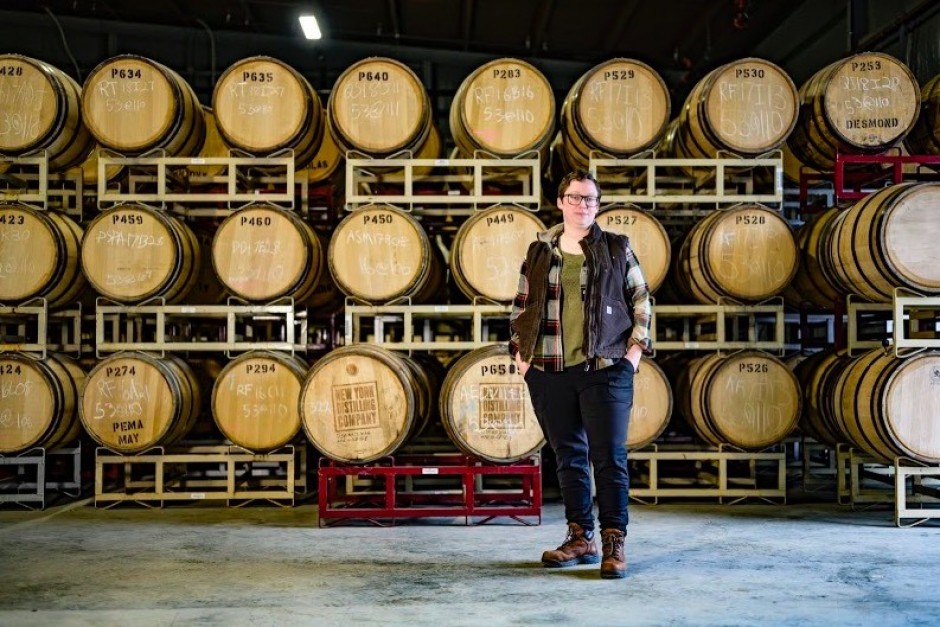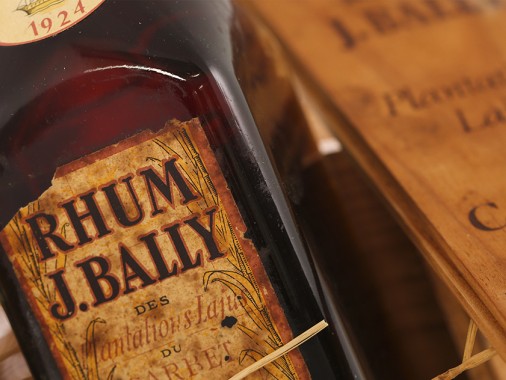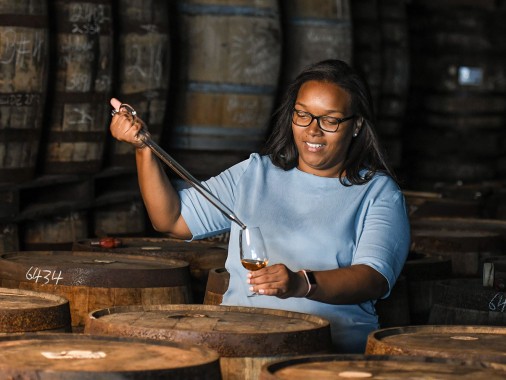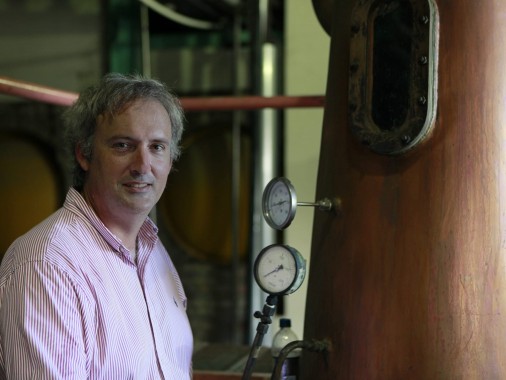 In Conversation With: Maggie Campbell, Privateer Rum
In Conversation With: Maggie Campbell, Privateer Rum We had the absolute pleasure of speaking with Maggie Campbell, Master Distiller at Privateer Rum, to find out more about her first steps in the rum world, the craft processes at Privateer, new collaborations with renowned independent bottler Velier and a new community space for Privateer rum fans.
Could you please introduce yourself explaining your role at Privateer Distillery including a brief overview of how you got involved in the rum industry?
I am the President and Head Distiller of Privateer. I oversee production and all cask selection and blending as well as working to connect and share with our Privateer community and the broader rum community. I work with our team to develop all our expressions and also do much of our market relationship work, marketing and PR. I had set out to work in whiskey, attending school and connecting with distillers and blenders. Dave Pickerell was my professor after he left Maker’s Mark and before he launched Whistle Pig. I thought for sure I’d make rye whiskey. Life had other plans and in a chance email inquiring about Cognac production I ended up Assistant Distiller at Germain-Robin (I also have a strong background in wine and winemaking making me well suited). It was Hubert Germain-Robin who years later met Andrew Cabot the visionary CEO of Privateer and recommended me for the job. I had a passion for minimal intervention winemaking, where your goal is to gentle guide what is made into the bottle without manipulation, and hoped to bring those philosophies to spirits and join others making traditional, authentic, and minimal intervention spirits. I found a great deal of products to be heavy with additives and heavy filtration.
Could you tell us about the story behind Privateer distillery and your guiding principles?
Andrew Cabot founded Privateer in 2011, at this time the vast amount of rum sold in the US was highly filtered, coloured, or sweetened. He was passionate about simple ingredients done well. He also recognized a lot of the big brand focus was on cutting costs and trying to be volume driven on small margins. As a small producer competing with their marketing was never going to work so, he went where others were not. He asked ‘How can I make a rum that earns an extra dollar rather than trying to cut and slash to a lower price?’ He knew being small, and handmade with high labour costs meant he needed to do what others could not and focus on best ingredients and best practices because the rum has to be good for folks to buy it. There is no marketing, no image that will make them buy it, it simply has to be good. When I met Andrew, we were totally in sync. I was passionate about best ingredients, quality production, no manipulation (no sweeteners, no age flavours (rancio syrup), no oak flavours (boise), and no aromatic additives or essences. To make rum that way you have to be quality minded and invested in a very skilled and dedicated team. It was a perfect fit.
What was the vision for Privateer Rum’s character and style of spirit and did this change or evolve in any way once production commenced?
We always wanted it to be bold yet elegant, firm yet layered, and have a point of view while also responding well to time and investigation. I tend to pile on the top note aromatics and mid palate flesh, Lead Distiller Peter (with us for 8 years) builds up a lot of the back palate and notes that open with time and air, and Managing Distiller Dylan (with us 5 years) hits front and layers on midpalate and core aromas. We are a great team who certainly make each other better. The structure has always been very linear with high flavour definition, our North Atlantic Maritime climate certainly shows here. We have always had a kick on New Oak as a nod to my Whiskey past and North American style but as we have gotten more established older and richer rums, and much more pot still, have come into the mix.
Can you tell us a bit more about your decision to switch to using traditional molasses from cane sugar?
We had always used cane sugar molasses but when I took over production there was already a few recipes for marks that included cane sugar crystals. I’ll admit the crystals were extremely high quality, minimally processed, deeply flavourful, and made good spirit. That said, we were aware that this pegged us as Craft North American rum and we wanted to be part of the global community. Then, our sugar supplier sold, things seemed to change, we would never be ok using a product we did not feel was the absolute best, and so we moved on from using it as it no longer suited us. Also, there was a moment when Richard Seale was on our distilling floor, he said kind things about those rums made from crystals, but he also said that we were seen as leaders, and when we use crystals other people think it is ok and other people do not source carefully nor make rum-like spirit from cane crystals. That landed different. So, right as we were transitioning into our dream molasses, from a single origin valley, we also switched off the cane crystals. That was about 2 years ago.
Can you share some insight into your craft at Privateer and your unique production processes such as rethinking the standard barrel proof?
Sure, for us 110 proof is standard and traditional proof, but yes in terms of rum it certainly is different. In the US 125 proof is seen as the standard entry proof, it is what all Bourbon is required by law to be at. Much rum in the Caribbean however is at 140 and even 160 proof. The higher a rum’s proof the less space it takes up (makes sense on an island), the more oak it extracts (makes sense as the Caribbean is often using very well used barrels), and the more the chemical interactions of oxidation and other aspects that create the flavour of maturity are inhibited (their warm mid 80’sF temperatures all year accelerate these aspects bringing balance). Meanwhile here in the US the temperature is very varied. We get hot summers that reach 100F and cold winters that go down to –10F with mild springs and falls. The lower proof allows the flavour of maturity the chug along in cooler and more mild weather and go off the charts over July and August summers. It also means a more gentle and slow extraction of oak that helps our integration as we are often using both new and once used casks. We do go into the traditional pre-1960s Bourbon proof of 110. This was thought to give the best flavour but the barrel proof of Bourbon was increased to allow producers to reduce expenses and barrel needs (the higher your proof, the less dilution/added water, and the less overall volume you have to store). When I taste the old Bourbons I love the plush texture and depth that I feel the old 110 proof standard brought.
Can you tell us about the impact the climate of New England has on your spirit in comparison to say that of the Caribbean?
As mentioned, we get hot and humid summers, dry and cold winters and lovely spring and fall. We truly get every season. For me it is all about showing off where your distillery is and highlighting your climate. We have a North Atlantic Maritime Climate. We see about 6% loss per year on entry. This climate means we get a range of climates adding diversity and layering of flavours as well as phases of gentle development and integration. In the summer proof drops in barrel, the rums become fleshy and richly textured. In winter the proof goes up, which helps extract a bit more oak from the cask, adding to the knit structure and bringing it back to a linear expression and keeping the rum from becoming to spread on the palate. We harvest in Fall and Spring when we feel each barrel is truly at its peak.
How did you first encounter the concept of the Queens Share and when did you decide you had to try it?
When I started at Privateer they had already made some so I learned it there. Andrew also has a little written documentation on the practice but like many things in rum, spoken word and trusted shared techniques taught me most. I have sense shared it with some old friends in Whiskey, there minds were each blown by the obvious simplicity of it and the powerful spirit it makes. It does however take time, dedication, and yields are small.
You recently collaborated with Velier as part of the Villa Paradisetto series, could you tell us about this experience?
It was lovely. As someone who is passionate about minimal intervention, no manipulation, and dedication to being in the service of the rum it was great to connect with the crew there. They have so much respect the work, effort, and energy it takes to make spirits like ours. It felt wonderful to be seen by them. Andrew and I flew to Genoa with a case of samples, tasted, shared our passions, and Velier gave us clear and direct feedback. It was wonderful. They picked their favorite casks and sent me home with a tall order to create a Habitation unaged expression, aged expression, and a micro-blend for Villa Paradisetto based on their tastes. It was a joy.
Privateer have a spectacular range of core and special releases. If you had to pick, which would be your favourite and why?
Oh man, that is brutal! I will say I have a very special place in my heart for our New England Reserve Rum. It is a humble aged expression, our entry level aged rum in fact, but we put a lot of heart and care in creating that blend. We hope it is approachable and cheerful for folks, but if you sit with it and really give it a chance there is a whole world in that rum. After that L’Alliance.
Are there any particular distilleries, or distillers, that you admire and have inspired your work at Privateer?
Oh yes of course, Todd Leopold and Leopold Bros. has been an inspiration since my earliest days and remain very important to me. He was a big part of why I am even still here distilling today, I might have given up if not for his encouragement. I admire Worthy Park a great deal, and of course Hampden, Foursquare, Michel Sajous, and the whole rum family though we never try to emulate them, they are masters of their own thing. Christoph Kellers eau de vies make me tear up a little.
What’s been your best moment so far at Privateer?
Another hard question! Honestly, I think the times we are just dancing around and goofing off early in the morning when the stills are just warming up. I truly love the people I work with.
And how about your biggest challenge?
I guess it depends how real we want to get... I have grown a lot at Privateer. Learning that I do not need to do it all myself was a big challenge, yeah, learning to hand off autonomy and really let those people thrive at directing themselves. I love it now though and we certainly are bigger and better than we could have ever been when I felt I had to do it all myself.
I would also like to be real and say I have had to deal with certain creepy bullies, especially being a woman, from time to time and it is exhausting, disappointing, and keeps me from being my full self and feeling secure at events. Threatening emails, stalker like behaviour at times - I mean I really don’t understand, I just make rum at a tiny company. I suppose people who like to exert power over others are always looking for a target and as a woman, often on her own as I move through the world, and without a massive company behind me I guess they see that as a low risk target for their bulls**t. It’s ultimately just sad and tedious if at times scary.
What’s your next focus at Privateer? Can you give us any insight into future releases?
We are starting to build more community space for our Privateer friends and fans. We’re calling it our Thief and Hammer Collective (a thief is what pulls your barrel samples out and a hammer is used to open a cask). It’s starting with some small, exclusive online tasting events. We’re also continuing to push hard to allow direct to consumer sales and the shipping of alcohol in the US. And of course, older and older rums! And yes, Richard Seale and I are still working on our collaboration vision.
Where would you like to see Privateer Rum in 5 and 10 years time?
I’d love to see a close and vibrant community around the fans, friends, and family of Privateer. Of course older and more powerful rums. I’d also like to see it accepted and called good rum generally rather than ‘good for American Rum’.







